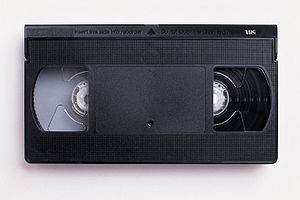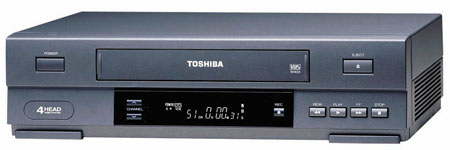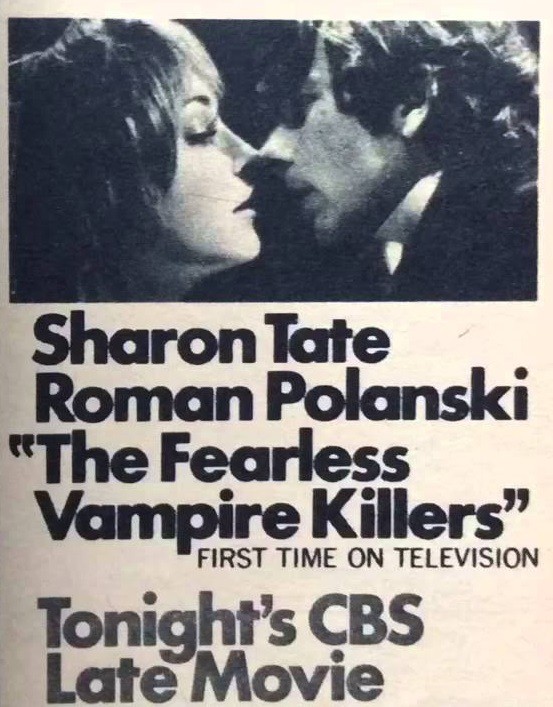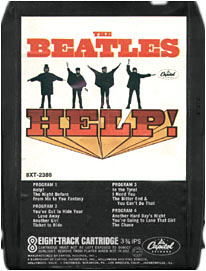
How many of these do you still have in your basement or attic? And more importantly, Be Kind, Rewind! (Image: Wikipedia)
The days of the Video Cassette Recorder (VCR) are coming to a quiet end as the last known manufacturer of the once-ubiquitous device announced it will stop making new machines at the end of July.
The VCR had its place in about 90 percent of U.S. homes just ten years ago. Although introduced to the consumer market in the late 1960s, the VCR remained a toy of the wealthy through much of the 1970s. It would take 10 years after that — the 1980s — for VCRs to become easily affordable and in enough homes to inspire a multi-billion dollar video rental industry with household names like Blockbuster. CNN even considered the VCR one of the most important cultural icons in its series The Eighties.
Like most new technology, the arrival of the VCR threatened everything, according to enterainment industry executives. Years of litigation dragged out issues like the right for consumers to make recordings of over-the-air stations to capture their favorite shows. Ad-skipping, courtesy of the fast-forward button, would “ruin” free television. Viewers might even build video libraries of shows and share them with friends and neighbors! At one time, some major companies in Hollywood even favored the imposition of a tax on blank videocassettes that would cover their losses from home recording. Copyright questions were finally settled in 1984, when the Supreme Court ruled home taping on a not-for-profit basis was perfectly legal. Hollywood survived despite this.
 Consumers had a choice between two incompatible standards – the Sony Betamax, which promised superior video quality or JVC’s VHS format, a standard that allowed for longer recordings and was supported by just about every electronics manufacturer other than Sony. Some consumers owned both, but most settled for one or the other, and the VHS tape had a decisive advantage – extended recording time and near universal accessibility. It would eventually dominate in sales. More than 30 years later, recordings made on Betamax and VHS machines are still viewable, and turn up on video websites, often showcasing television as it used to look like in the 1970s and 1980s.
Consumers had a choice between two incompatible standards – the Sony Betamax, which promised superior video quality or JVC’s VHS format, a standard that allowed for longer recordings and was supported by just about every electronics manufacturer other than Sony. Some consumers owned both, but most settled for one or the other, and the VHS tape had a decisive advantage – extended recording time and near universal accessibility. It would eventually dominate in sales. More than 30 years later, recordings made on Betamax and VHS machines are still viewable, and turn up on video websites, often showcasing television as it used to look like in the 1970s and 1980s.
The VCR became so popular, it was a significant part of our lives. Pornography on videotape became a major issue during the Reagan Administration. But an even more pervasive problem was the flashing 12:00 time on your grandparent’s unconfigured VCR and the piece of black electrical tape used to conceal it. Videocassette clubs became as common as the record clubs that were around decades earlier. Parents used the VCR as an electronic babysitter to entertain children. Movie rental night was also the best way to watch your second, third, or fourth choice movie, as popular titles were cleared off shelves early in the evening. Rental fees, late fees, and “be kind, rewind” fees were also issues. But the worst nightmare of all was the horror of discovering a hopelessly unwound and tangled videocassette inside the machine, or worse, your child’s lunch.

What the VCR was invented for: time-shifting
First generation VCRs were replaced with Hi-Fi and even SuperVHS models, which improved recording quality. Consumers bought second and third units for their bedrooms. Blank videocassettes were everywhere, often available hanging on a rack next to the checkout line.
The VCR was technology America took for granted… until the arrival of DVDs in 1995, just a decade after the VCR really got popular. There was simply no comparison. The DVD blew away videocassette video quality and offered easy accessibility, compact storage, and a longer lifespan. Just five years after the DVD showed up, it outsold all videotape formats combined. The pay television industry completed the hatchet job on the VCR with the introduction of the Digital Video Recorder (DVR) (Personal Video Recorder, or PVR, in Canada). The DVR was designed around the fact most consumers used VCRs to time-shift television programming, not build a personal library of recordings. With a DVR, a customer could quickly record their favorite shows and store them digitally, erasing unwanted shows with the push of a button.
The DVR still shows years of life, but the DVD’s days are likely numbered as cloud storage and on-demand video streaming make the need to collect and organize a library of shows and movies obsolete. Why buy it if you can stream it?
Manufacturers and retailers have noticed the shifting trends and the VCRs that were originally for sale in the 1980s were largely replaced by DVD players in the 1990s. Today, even DVD players are slowly being replaced in favor of devices like Roku or portable tablets.
Until this month, at least one manufacturer – Funai of Japan – still had a small niche market keeping VCRs in homes where owners spent decades amassing vast video libraries of movies and TV shows. Unfortunately, Chinese manufacturers of the parts needed to build a VCR have increasingly lost interest. So has Funai.
“We are the last manufacturer” of VCRs “in all of the world” — 750,000 units were sold worldwide in 2015, down from millions decades earlier, said Funai, which sold them under brand names like Sanyo, among others. This last holdout made VHS machines. Sony threw in the towel on making Betamax VCRs back in 2002. It stopped manufacturing blank tapes this year.

The infamous 8-track tape, just one of many orphaned recording media formats.
At some point in the next 10-20 years, the videocassette could represent one of the largest orphaned recording formats around. As little as 20 years from now, as your kids and grandchildren unearth strange plastic boxes from the attic or basement, they will wonder what they are and how to play them. Preservationists are concerned about the inevitable – discovering playable videocassettes have outlived the players required to watch them.
It isn’t the first time. Wire recordings still turn up in some attics. To the uninformed, they are nothing more than a spool of ordinary wire, except someone recorded sound on them sometime in the first half of the 20th Century. Even more common, open reel or reel-to-reel tapes wound on large plastic spools. This was the audiophile’s choice during much of the vinyl era, where the alternative was the obnoxiously awful 8-track tape or the hissy audio cassette.
If a radio broadcaster lived in your home, you might still find a few Fidelipac cartridges that slightly resemble 8-track tapes. These were commonly used to store continuous loop/always ready to go commercials and jingles. RCA developed its own version of the “Stereo Tape” in 1958 that came and went faster than the DuMont television network. In 1962, Muntz tried a Stereo Pak 4-track tape that went over like a yellow jacket swarm at a summer picnic. In 1966, the two track PlayTape format showed up and the only place you were likely to ever encounter it was inside certain Volkswagen automobiles. In 1977, someone had the brilliant idea of taking reel-to-reel size tape and loading it into a giant cassette-like shell. The Elcaset was born with a gigantic price tag. Unfortunately for the inventors, most consumers thought regular cassettes sounded good enough.
From the 1970s on, videotape was where it was at, and early formats were likely wound on spools or inserted into cartridges with strange-sounding names like U-matic. TV station personnel knew about these formats, but most consumers didn’t.
Making audio sound better in the 1980s brought three more attempts to recreate the portable cassette-like experience in a digital format. In 1988, Digital Audio Tape (DAT and R-DAT) arrived. It promised CD audio quality recordings. The record industry promised to destroy it at all costs because it could make perfect digital copies, great for bootlegging and pirating. It never emerged from niche status. The same was true for Sony’s bizarre MiniDisk, introduced in 1991. A sort of recordable CD-like disk placed inside a computer disk-style cartridge, it won some market share in Japan, but was never more than a curiosity in North America. If record companies didn’t release albums on these formats, they tended to tie quickly. Helping it along to the grave was copy protection technology, which irritated some users. In the end, the MiniDisk was deemed irrelevant after MP3 players arrived.
Philips of the Netherlands and Sony of Japan made one last effort before the MP3 rage with their 1992 introduction of the Digital Compact Cassette. Its main selling point was that players were backwards compatible and could also play ordinary cassettes (the things most consumers were starting to shove into drawers and shoe boxes the moment digital audio formats like MP3 took off). Too little, too late, and although Philips had a small loyal following for their players in Holland, you now have a better chance of finding blank digital cassettes stuffed into the back of drawers than you will ever have encountering a player to play them on.


 Subscribe
Subscribe
Wow, great article! I’m feeling nostalgic, and kind of weirded out by VHS going away, and the realization we’re (once again) likely to lose a gigantic swath of movies and the like :-/